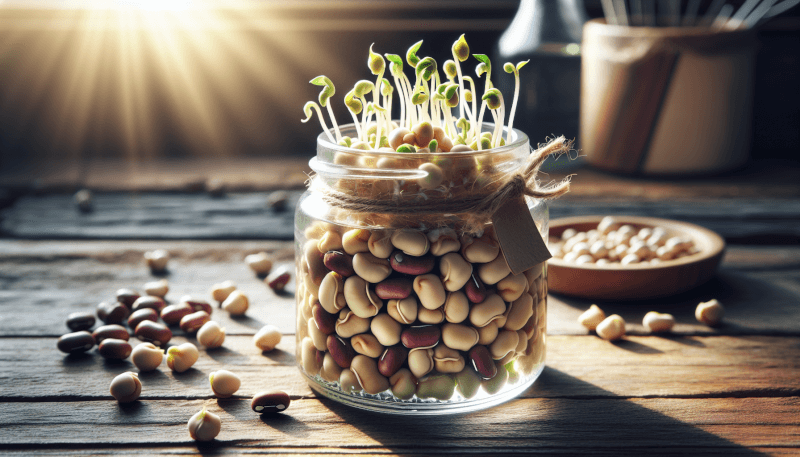👋 Click the mic button to talk to Alfred, the Todd's Seeds Gardening/Sprouting Expert – Feel free to ask him anything!
Ask Virtual Todd Anything - Click the Mic
Sprouting legumes are a fantastic addition to any diet, bursting with both flavor and nutritional benefits. But what exactly are they? Well, sprouting refers to the process of germinating legumes, like lentils or chickpeas, by soaking them in water and allowing them to grow tiny sprouts. These sprouts are not only deliciously crunchy but also pack a punch in terms of their health benefits. From increased vitamin content to improved digestibility, sprouting legumes are a simple yet effective way to enhance the overall nutritional value of your meals. So, if you’re ready to discover the wonders of sprouting legumes, let’s dig in and explore these tiny powerhouses together!

What Are Sprouting Legumes?
Sprouting legumes are legumes that have been allowed to germinate and grow into young plants before they are consumed. This process involves soaking the legumes in water until they swell, and then rinsing and draining them regularly until tiny sprouts emerge. These sprouts are rich in nutrients and can be a valuable addition to a healthy diet.
Nutritional Benefits of Sprouting Legumes
Sprouting legumes can provide numerous nutritional benefits. When legumes are sprouted, their nutrient availability increases. This means that the body can absorb and utilize the nutrients from sprouted legumes more efficiently. Additionally, sprouting legumes enhances their digestibility, making them easier on the digestive system and reducing the likelihood of discomfort or bloating.
Another advantage of sprouting legumes is the improved antioxidant activity. Sprouts contain higher levels of antioxidants than their unsprouted counterparts, which can help protect the body against oxidative stress and promote overall health. Furthermore, sprouting legumes can boost their protein content, making them a suitable choice for individuals looking for plant-based sources of protein.
Types of Legumes That Can Be Sprouted
Several types of legumes can be sprouted to enjoy their nutritional benefits. Mung beans are one popular option, known for their delicate flavor and crunchy texture. Adzuki beans, with their slightly sweet taste and vibrant red color, are another great choice. Lentils, available in various colors such as green, brown, and red, are widely used for sprouting. Chickpeas, which are a staple in many cuisines, can also be sprouted to add a unique twist to dishes.
How to Sprout Legumes at Home
Sprouting legumes at home is a straightforward process that requires a few simple steps. Begin by soaking the legumes in water overnight or for a minimum of 8 hours. After soaking, rinse the legumes thoroughly and drain away the excess water. Place the legumes in a container with proper air circulation, such as a sieve or a sprouting jar with a mesh lid. Rinse and drain the legumes twice a day, ensuring they remain moist but not waterlogged. Within a few days, the sprouts will be ready to harvest and enjoy.
Sprouting Legumes and Nutritional Benefits
Sprouting legumes offers additional nutritional benefits compared to consuming them in their unsprouted form. The process of sprouting increases the vitamin and mineral content of legumes. Sprouts are particularly rich in vitamins C and K, as well as minerals like iron, magnesium, and potassium, which are essential for maintaining good health.
Furthermore, sprouting legumes stimulates enzyme activity. Enzymes are responsible for breaking down food and aiding digestion. Sprouted legumes contain higher levels of enzymes, which can improve digestion and help the body absorb nutrients more effectively.
Additionally, sprouting legumes can enhance the amino acid profile. Amino acids are the building blocks of proteins, and sprouts offer a more diverse range of amino acids compared to unsprouted legumes. This makes sprouted legumes a valuable addition to a balanced diet, especially for individuals following a plant-based or vegetarian lifestyle.
Potential Risks and Precautions
While sprouting legumes can offer many benefits, it is important to be aware of potential risks and take necessary precautions. First, there can be food safety concerns associated with sprouting. The warm and moist conditions required for sprouting can also promote the growth of harmful bacteria like Salmonella or E. coli. It is crucial to ensure that the legumes used for sprouting are of high quality and have not been contaminated.
Moreover, individuals with allergies should be cautious when consuming sprouted legumes. Allergies to legumes such as peanuts or soybeans may extend to sprouts as well. It is essential to identify any potential allergens and avoid consuming sprouted legumes that may cause adverse reactions.
Proper storage and handling of sprouted legumes are also important. After sprouting, store them in the refrigerator and consume them within a few days to minimize the risk of bacterial growth. Thoroughly wash your hands, utensils, and sprouting equipment to maintain hygiene and prevent cross-contamination.
Incorporating Sprouting Legumes into Your Diet
There are various ways to incorporate sprouting legumes into your diet, allowing you to enjoy their nutritional benefits in delicious and creative ways. Sprouts can be added to salads and sandwiches, lending a refreshing crunch and adding an extra layer of flavor. They can also be included in stir-fries and sautés, providing a nutritious twist to traditional dishes. For a quick and easy boost of nutrients, blend sprouts into smoothies or juices. Finally, sprouted legumes can be used as a base for diverse dishes such as curries, stir-fries, or even burgers, offering a satisfying plant-based alternative.
Conclusion
Sprouting legumes is a simple yet effective way to enhance their nutritional content and make them easier to digest. Whether you choose mung beans, adzuki beans, lentils, or chickpeas, sprouting legumes can provide increased nutrient availability, improved antioxidant activity, and boosted protein content. By following the steps to sprout legumes at home and taking necessary precautions, you can enjoy the benefits of sprouted legumes while adding a nutritious and versatile element to your diet. So why not give sprouting legumes a try and reap the rewards of their goodness? Happy sprouting!

